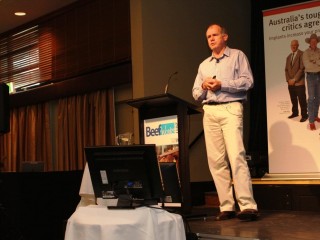 In theory feedlots seem well-positioned to benefit from the mountains of manure they produce each year under a carbon pricing scheme – either by using it to increase income-generating soil carbon or converting it into liquid natural gas to generate their own power and cut their electricity bills.
In theory feedlots seem well-positioned to benefit from the mountains of manure they produce each year under a carbon pricing scheme – either by using it to increase income-generating soil carbon or converting it into liquid natural gas to generate their own power and cut their electricity bills.
But the reality is not that simple, according to Mick Keogh from the Australian Farm Institute.
Few people in agriculture have studied the detail of existing and proposed carbon pricing legislation in more depth than Mr Keogh, and he yesterday outlined the sobering reality of its content at the Australian Lot Feeders Association’s BeefWorks 2011 conference.
His primary message was the carbon pricing scheme will be subjected to such complicated rules and systems that most opportunities to earn income or cut costs will be limited. In fact most analysis at this stage indicated that the only activity likely to produce a net-benefit over time was single-species tree plantations in high-rainfall zones.
Mr Keogh said that the immediate implication for feedlots when the carbon pricing scheme comes into effect from July next year will surround their energy use.
The rough predictions are that a feedlot with around $80,000 of electricity going into its mill each year would face a 10-15pc increase in electricity costs as a consequence of the carbon price quite early in the scheme, and those costs would continue to rise from there.
As a result many feedlots were looking into whether the potential exists to use methane from their manure collections to generate their own power and reduce or even eliminate their electricity usage.
The most likely option involves installing a closed system where manure is pushed into deep, covered pits, and then capturing and compressing the methane into liquid natural gas which can then be used to run a generator. Some piggery and poultry operations are already using manure treatment systems and have the potential to generate more methane-derived electricity than they can use.
But this process is far from a free ticket to lower energy costs. The capital expense involved to install methane capture and compression systems runs into the hundreds of thousands of dollars as a minimum, and millions of dollars for larger operations. Whether ongoing electricity savings would justify the high establishment costs is yet to be seen.
The other main question for feedlots is whether they can use the manure they produce to increase soil carbon and generate income under the carbon pricing scheme.
Existing detail at this point suggest the existing rules may be too onerous to allow this to happen in reality.
Distributing manure on pasture comes with the initial warning that the methane associated with the breakdown of that manure over time would also be factored into the carbon credit/deficit calculation. It is possible that landholders could end up with increased net emissions as a result of this activity and a bill, rather than a decrease and a credit.
Soil carbon is also currently factored into the voluntary scheme, so credits would be worth far less than those earned under the mandatory scheme.
But perhaps the greatest warning for anyone seeking to undertake soil carbon sequestration contracts under the existing Carbon Farming Initiative legislation is the issue of “permanence”.
“If you want to undertake soil carbon sequestration the contracts will require you to undertake to maintain that increased level of soil carbon permanently, so for 100 years,” Mr Keogh said.
“The legislation talks about a carbon maintenance obligation, in other words a legal requirement for you to maintain that carbon, and a carbon restoration obligation.
“So in other words if you don’t, the legislation includes the ability to issue orders to force you to restore that carbon back to where you thought it was going to be.”
If landholders are able to increase soil carbon, the message is that they have to keep increasing it, they can’t just increase it for a couple of years and then let it slide again.
Going down the soil carbon sequestration path would also almost certainly limit the future land use options available to landholders. Mr Keogh said no cropping system had yet been shown to be able to deliver ongoing increases in soil carbon. The best that cropping systems had been shown to achieve was a maintenance of soil carbon.
“Anyone wanting to go down the soil carbon track would almost certainly have to do it via a permanent improved pasture and not go back to cropping on that land, so they would also be restricting their land use.”
Mr Keogh said the key message for any rural business was to take all the time they needed to fully understand how carbon policy works before taking the plunge and committing to contracts.
